Mac News Review
Sony to Film Steve Jobs Biography, Huge Mac Growth in US Market, New Raven Web Browser, and More
This Week's Apple and Desktop Mac News
Compiled by Charles Moore and edited by Dan Knight - 2011.10.14
Mac notebook and other portable computing is covered in The 'Book Review. iPad, iPod, iPhone, and Apple TV news is covered in iOS News Review. All prices are in US dollars unless otherwise noted.
News & Opinion
- Sony Acquiring Steve Jobs Biography for Major Feature Film
- Finding an Actor to Play Steve Jobs
- Expected Specifications for the Next Mac Pro
- Could Removing DRM Decrease Music Piracy?
- OCZ Purchases Oxford Semiconductors
Tech Trends
- Gartner: Worldwide Q3 2011 PC Shipments Up 3.2%; Apple Up 21% in US
- IDC: Worldwide PC Market Grapples with Slow Growth in Third Quarter, but Apple Soars Domestically
Products & Services
Software
- Raven, a New Site-specific and Social Networking Browser for OS X
- Adobe Offers 20% Off When Upgrading from CS2, CS3, and CS4 to CS 5.5
Desktop Mac Deals
News & Opinion
Sony Acquiring Steve Jobs Biography for Major Feature Film
Deadline.com's Mike Fleming reports that he's just learned that Sony Pictures is making a hefty deal to acquire feature rights to Steve Jobs, the upcoming authorized biography by former CNN chairman and Time Magazine managing editor Walter Isaacson. The Isaacson book was supposed to be published on November 21st by Simon & Schuster, but now the release date has moved up to October 24th, according to a spokeswoman for the publisher.
At the time of Jobs death, only one movie had ever chronicled his rise to tech titan: Pirates of Silicon Valley, a semi-humorous docudrama about the two visionaries behind Microsoft and Apple based on the book Fire In The Valley: The Making of The Personal Computer by Paul Freiberger & Michael Swaine. The movie starred Anthony Michael Hall as Bill Gates and Noah Wyle as Jobs. Reportedly, Jobs thought the ER actor did a fantastic job donning the turtleneck. And, during the Macworld NY in July 1999, Jobs had Wyle come out dressed like him to start the keynote.
Link: Sony Pictures Acquiring New Steve Jobs Biography for Major Feature Film (preorder Steve Jobs in hardcover from Amazon.com for $17.88, or get the Kindle edition for just $16.99)
Finding an Actor to Play Steve Jobs
Cnet's Edward Moyer asks:
"Who would you pick to play Steve Jobs in a feature-length fimic biography of the tech titan?
"You can bet that question is being pondered mightily by producer Mark Gordon and his production entity MG360, who, along with Sony Pictures, may eventually bring such a biopic to the screen. (And you can bet an actor or three is howling at his agent to 'Get me that part!')
"We're wondering if Noah Wyle is possibly in the running. As you may recall, the ER star played Jobs in the 1999 made-for-TV flick Pirates of Silicon Valley, opposite Anthony Michael Hall's Bill Gates."
Moyer also includes a video of Wyle's 1999 turn at the Macworld New York keynote standing in briefly for the real Steve Jobs.
Link: Casting About for an Actor to Play Steve Jobs
Expected Specifications for the Next Mac Pro
Hardmac's Lionel, citing information from the Chinese language Website it.com.cn, notes that while he has been expecting new models of Mac Pro to come out in late 2011 or even early 2012, he's getting more and more information about the components that will likely be inside, such as the Sandy Bridge E processors and now their chipset X79, on which one of the Mac Pros will be based, both for the single and dual processor models, along with:
- Support of 4 channels of memory, up from 3 on the current model
- 64 PCI-Express links, enough to have several 8x and 16x slots and Thunderbolt
- 14 SATA connections, 10 of which will be SATA III with native support of RAID 0, 1, 5, 10, and JBOD
- 14 USB 2.0 connections. If Apple wants to include support for the USB 3.0, an extra chip will have to be added, or you will have to add a specific card for that, which at least is easy to do on the Mac Pro.
Link: More Information About Expected Specifications of the New Mac Pro
Could Removing DRM Decrease Music Piracy?
CDRinfo reports on new research that challenges conventional wisdom that removal of restrictions would increase piracy levels. Contrary to the traditional views of the music industry, removal of digital rights management (DRM) restrictions can actually decrease piracy, according to new research from Rice University and Duke University.
Marketing professors Dinah Vernik of Rice and Devavrat Purohit and Preyas Desai of Duke used analytical modeling to examine how piracy is influenced by the presence or absence of DRM restrictions, which prevent unauthorized copies of digital data, such as music, from being made. They found that while these restrictions make piracy more costly and difficult, the restrictions also have a negative impact on legal users who have no intention of doing anything illegal.
"...Steve Jobs said it best: 'Why would the big four music companies agree to let Apple and others distribute their music without using DRM systems to protect it? The simplest answer is because DRMs haven't worked, and may never work, to halt music piracy,'" Vernik comments.
The findings will appear in the November-December issue of Marketing Science.
Link: Removing DRM Could Decrease Music Piracy, Researchers Say
OCZ Purchases Oxford Semiconductors
Hardmac's Lionel reports that after purchasing Indilynx, OCZ has decided to purchase the European division of PLX, which was originally part of Oxford Semiconductors.
This name is pretty well known since it was Oxford which made the first controllers to make FireWire hard drive cases 10 years ago. Lionel says he now hopes that OCZ will let Oxford continue the development of SATA-FireWire controllers, because otherwise, the market would use one of the most active companies in that field, with the market shrinking every day with wider adoption of USB 3.0.
Link: OCZ Purchases Oxford Controllers
Tech Trends
Gartner: Worldwide Q3 2011 PC Shipments Up 3.2%; Apple Up 21% in US
PR: For the first time, Lenovo is No. 2 in PC sales worldwide, displacing Dell, according to a new report from Gartner Inc., but domestically, Apple is leading the growth pack with a whopping 21.5% increase in PC sales, spearheaded by the robust popularity of the MacBook Air with US consumers.
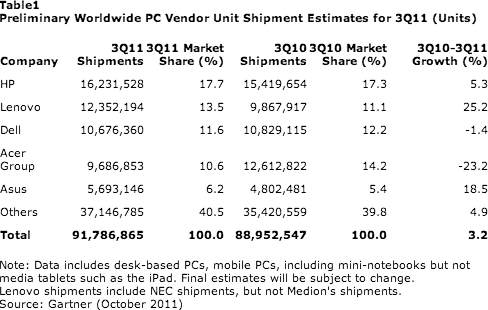
Gartner Inc. reports that worldwide PC shipments totaled 91.8 million units in the third quarter of 2011, a 3.2% increase year-over-year according to preliminary results, which are coming in slightly lower than Gartner's earlier projection of 5.1% growth for the quarter. The EMEA [Europe, Middle East, Asia] region contributed to lower-than-expected growth led by a weak Western European market.
"The inventory buildup, which slowed growth the last four quarters, mostly cleared out during the third quarter of this year; however, the PC industry has been performing below normal seasonality," says Gartner principal analyst Mikako Kitagawa. "As expected, back-to-school PC sales were disappointing in mature markets, confirming that the consumer PC market continues to be weak. The popularity of non-PC devices, including media tablets, such as the iPad and smartphones, took consumers' spending away from PCs.
"As the PC market faced a slowdown, vendor consolidation has become a more apparent trend in the industry. Lenovo's recent merger with NEC, and its acquisition of Medion, as well as HP's announcement that it may spin off or sell its PC business, underlined this trend during the quarter."
The report notes that HP, the No. 1 vendor based on global PC shipments, grew faster than the industry average, its market share reaching 17.7% in the third quarter of 2011 (see Table 1). Despite announcing in the middle of 2Q11 the potential spinoff of its PC business, HP experienced strong growth in the US, while outside the US, growth was relatively weak or average.
Lenovo has become the second-largest PC vendor in the worldwide market for the first time - the company's expansion boosted in part by the joint vendor with NEC in Japan. However, aggressive marketing to both the professional and consumer PC markets also accelerated Lenovo's shipment volume.
Dell's performance was below the industry average in most regions, as the company faced intensified competition in the professional space, where Dell has been traditionally strong. Acer mostly cleared its inventory buildup in the EMEA region by the third quarter of 2011. However, channels have been adopting a conservative position in regard to placing orders following the inventory issues. Asus widened the gap with Toshiba, the sixth-largest vendor. Asus achieved strong growth in China.
In the US, PC shipments totaled 17.8 million units in the third quarter of 2011, a 1.1% increase from the third quarter of 2010. The US PC market experienced year-over-year growth for the first time in three quarters. While the consumer market continued to be weak with disappointing back-to-school sales in the third quarter, the inventory was kept mostly in check as industry expectations were relatively low.
"The main contributor to the weak consumer PC market in the US was intensified competition for consumers' money," Ms. Kitagawa says. "Media tablets and smartphones took center stage in the US retail sector, and the expectation is for continuing demand for these devices throughout the holiday season."
HP showed strong growth in the US PC market, as shipments increased 15.1% in the third quarter, and its market share totaled 28.9% (see Table 2). Despite the potential spinoff of its PC business, HP executives' efforts to give the appearance of "business as usual" seemed to work in the quarter.
Dell struggled as shipments declined 7.2% in the third quarter of 2011. "Dell's issue has been balancing profitability and market share gain, a difficult task in a PC industry where high volumes and low margins are the norm," Ms. Kitagawa said.
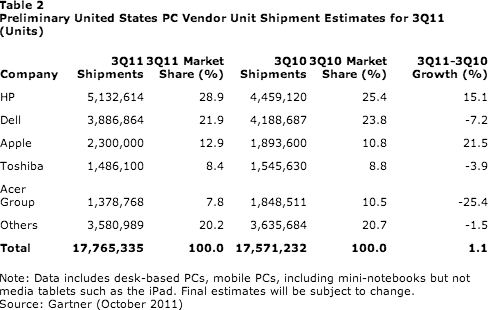
Gartner's early study shows that Apple experienced the strongest growth among the top five vendors in the US PC market. Apple's PC shipments increased 21.5% in the third quarter of 2011. The robust growth of the MacBook Air continued to lead Apple's overall growth in the US market.
PC growth in EMEA reached 26.6 million units in the third quarter of 2011, a 2.9% decline from the second quarter of 2010. It was the third consecutive quarter that the EMEA region has experienced negative growth. However, analysts said vendors may have seen the end of backed-up inventory issues, which have been pulling down growth. The consumer PC market in Western Europe remained weak, with consumer confidence permanently shaken by the economic issues spreading across most of the region. Furthermore, the market share of mini-notebooks continued to decline, especially in Western Europe, which also contributed to the weak year-over-year comparison.
In Asia/Pacific, PC shipments reached 31.8 million units in the third quarter of 2011, a 6% increase from the same period last year. Vendors continued to stimulate demand aggressively with promotions and prices, benefiting buyers looking for good prices. It also provided an opportunity for some consumers to buy their first mobile PC.
The PC market in Latin America grew 19.6% in the third quarter of 2011. Mobile PC shipments grew 31.1% year over year, and desk-based PC shipments increased 6.5% in the third quarter of 2011.
PC shipments in Japan grew 3%, with shipments reaching 3.9 million units. The consumer market received a boost in demand with the introduction by vendors of new consumer models in September. There was also a rebound in production for the professional market, after a drop in enterprise demand because of the higher prioritization for business continuity plans that coincided with the earthquake and tsunami in March.
These results are preliminary. Final statistics will be available soon to clients of Gartner's PC Quarterly Statistics Worldwide by Region program. This program offers a comprehensive and timely picture of the worldwide PC market, allowing product planning, distribution, marketing and sales organizations to keep abreast of key issues and their future implications around the globe. Additional research can be found on the Computing Hardware section on Gartner's website.
Link: Market Share Alert: Preliminary PC Market Results, Worldwide, 3Q11
IDC: Worldwide PC Market Grapples with Slow Growth in Third Quarter, but Apple Soars Domestically
PR: Worldwide PC shipments increased by 3.6% in the third quarter of 2011 (3Q11) compared to the same quarter in 2010, according to the International Data Corporation (IDC) Worldwide Quarterly PC Tracker. However, Apple broke from the pack with total Apple PC shipments increasing more than 20% in 3Q11, the hot-selling MacBook Air continuing to boost volumes.
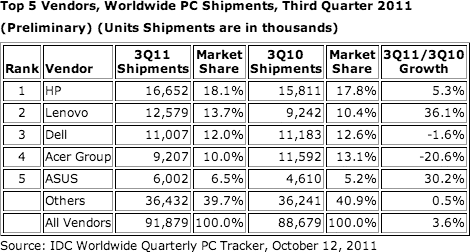
The results are up slightly from the 2.7% growth experienced in 2Q11, and just below IDC's August projections for 4.5% growth in the quarter. The Americas and EMEA were slightly below expectations while the Asia/Pacific markets were slightly ahead. The market continues to struggle as consumer discretionary income is diverted to other areas and business spending remains depressed in light of other priorities and a potential double-dip recession.
"For the moment, PCs have taken a back seat to a range of other devices competing for shrinking consumer and business budgets," says Jay Chou, senior research analyst with IDC's Worldwide Quarterly PC Tracker. "While growth is expected to stay in mid-single digits in the fourth quarter, we should see faster growth in 2012 and beyond based on easier comparisons and refreshed PC offerings as the industry better addresses the evolving usage models by integrating more of the features in ultra mobile devices."
"Most vendors continue to struggle with the slow market environment and product changes," comments Loren Loverde, IDC vice president of Worldwide Consumer Device Trackers. "Although we don't see media tablets and other devices replacing PCs, questions on how products will evolve, and consumer interest in these and other categories are providing a distraction. And while price remains critical, many users are delaying PC purchases for the moment. Still, there are opportunities, as demonstrated by Lenovo's gains, and we expect PCs to find stronger demand in the coming years."
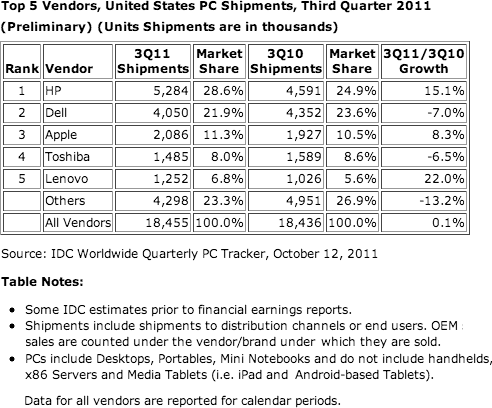
"The US market came in about flat as expected, but failed to generate positive momentum given the state of saturation and lack of incentives for consumers to upgrade. Other inhibitors included the poor economic environment and, to a certain extent, iPad cannibalization," said David Daoud, IDC's Personal Computing Research Director. "As we approach the holiday season, the opportunity for low single-digit growth is real, but mostly as a result of poor market conditions last year, as opposed to a recovery in demand."
Regional Outlook
The United States market came in roughly flat with year ago shipments as the consumer and commercial demand remained constrained. Nevertheless, the market moved out of negative growth and HP registered strong growth going into the holiday season.
Europe, Middle East, Africa (EMEA) performed in line with forecast as the PC market continued to shrink in the third quarter across both desktop and portable form factors. The back-to-school season saw sustained weakness in consumer demand, with spending being diverted to media tablets and smartphones, while vendors and channel players remained focused on clearing consumer notebook inventory before taking new stock. Besides weak consumer trends, commercial demand has also slowed down, indicative of the increasing caution and postponed investments as a response to the current economic and financial turmoil in the Euro-zone and the US
Japan continued to see growth in low single-digits. Lenovo finalized its merger with NEC, leveraging its scale and becoming the clear market leader. Although power rationing affected some commercial purchases, the market by and large continued to see more adoption of both consumer and business PCs.
Asia/Pacific excluding Japan (APeJ) had a strong quarter with double-digit growth, meeting expected volume. The region managed to regain momentum, reversing two previous quarters of only single digit growth due to gains in China and India, as well as good volume in Indonesia and Thailand.
Vendor Outlook
HP grew 5.3% year on year, thanks to double-digit growth in the US The company has been criticized for management missteps in the past few months, and been affected by slower consumer demand in many regions, but managed to outpace overall market growth nonetheless.
Dell continued to make gains in APeJ and CEMA, but declines in more mature regions pulled overall growth to 1.6% year on year. Dell faced tough competition and had sizable declines in some markets. However, its continued expansion efforts in China continued to pay dividends, maintaining double-digit growth in Asia/Pacific (excluding Japan).
Lenovo experienced strong gains across all regions as it continues its channel expansion and capitalizes on disarray among the other top players. Lenovo has now outpaced the market by more than 10% for the past 9 quarters, and by 20% or more in six of these periods. The results moved Lenovo ahead of Dell in 3Q11 after trailing by a small margin in the second quarter. Lenovo's partnership with NEC and the acquisition of Medion added incremental volume and provided new access to the Japanese and Western European markets.
Acer continued to struggle with inventory clearing and adjusting its strategy following declines in mini notebooks and its management shakeup. Total shipments were down 20.6% from a year ago the fourth consecutive quarterly decline but easier comparisons may help the company turn a corner in coming quarters.
ASUS had a strong quarter, boosting growth to over 30%. Strong gains in Asia/Pacific, along with improvements in EMEA, helped ASUS overtake Toshiba for the number 5 spot in worldwide shipments. While the vendor has had some difficulties adjusting for the decline in mini notebook PCs, its mainstream notebooks have done well, especially in emerging markets.
Apple Total shipments increased more than 20% in 3Q11, recovering from a dip to 15% growth in the second quarter but otherwise continuing a trend of more than 2 years with over 20% growth. The MacBook Air continues to boost volumes, and Apple's position in driving changes in consumer expectations for devices also positions it favorably relative to other players and tight consumer spending.
IDC's Worldwide Quarterly PC Tracker gathers PC market data in over 80 countries by vendor, form factor, brand, processor brand and speed, sales channel and user segment. The research includes historical and forecast trend analysis as well as price band and installed base data.
Link: IDC
Products & Services
Free Digitized Copy of Guy Kawasaki's The Macintosh Way Available from OfficeDrop and Pixability
PR: A newly digitized version of Guy Kawasaki's groundbreaking technology marketing book, The Macintosh Way, is now available for free download.
OfficeDrop, a document scanning and digital filing system startup, provided the scanning services that turned an old copy of the book that was sitting on Guy's bookshelf into a text-searchable PDF. Pixability, a video marketing service, filmed the rebirth of the book surrounded by well-known Apple products since the book was written, including the original Macintosh 512K, a working Newton, and the original Bondi iMac. See the video at http://pixability.com/kawasaki
In The Macintosh Way, Guy Kawasaki outlines the principles of technology evangelism. Although the work remains a highly topical guerilla marketing book, the publisher let it go out of print. Guy recently regained the rights to his book, and wanted to digitally distribute it as a PDF for free to his Twitter followers.
"Information wants to be free, and now I can provide my very first book to everyone for free. OfficeDrop and Pixability were indispensable parts of this liberation effort," says Guy.
"We were happy to take on such an exciting project, and working with Guy was a lot of fun," said Healy Jones, VP of Marketing at OfficeDrop. "The Macintosh Way is an important book for many technology startups, and we were honored to turn it into a great ebook. People can also get the book for free on their iPad with OfficeDrop's new iPad Paper-to-Go app."
To document the entire destruction and resurrection of the book, Pixability took footage of the scanning process and edited a video to tell the story of The Macintosh Way. The finished video follows Kawasaki's work throughout the conversion process and cleverly features the progression of Apple products over more than 20 years. The Vintage Mac Museum supplied most of the working Mac computers.
Pixability's CEO Bettina Hein comments, "We jumped at the opportunity to tell the story of rebirth in The Macintosh Way on video. It's a great story, and we think viewers will enjoy seeing the progression of Kawasaki's work from printed copy to an ebook."
Visit freemacway.com to get your free copy of the book or OfficeDrop to get it on your iPad.
Link: freemacway.com
Software
Raven, a New Site-specific and Social Networking Browser for OS X
PR: Raven is a new Web browser for Mac OS X. At first glance, Raven resembles an iPad app, but its main innovation is in how it handles Web apps. When you install an app, it shows up in the sidebar from which you can access site-specific commands with a click. When the content in any of your apps is updated, a subtle blue reminder light next to its icon in the browser sidebar will appear.
 Raven uses a
technique called "site specific browsing" to create a dedicated browser
and debuts with the most widely-used social networking websites
including Google+, Facebook, Twitter, and Quora. Within each app, Raven
provides yet another instance for key features. This provides a whole
new level of multitasking within a single window. The Raven Smart Bar
unifies navigation across many different websites, allowing access to
features quickly, without effort and with little instruction.
Raven uses a
technique called "site specific browsing" to create a dedicated browser
and debuts with the most widely-used social networking websites
including Google+, Facebook, Twitter, and Quora. Within each app, Raven
provides yet another instance for key features. This provides a whole
new level of multitasking within a single window. The Raven Smart Bar
unifies navigation across many different websites, allowing access to
features quickly, without effort and with little instruction.
The developers say they created Raven with the belief that if a browser provided a more helpful hand, Web apps would not have to work as hard to mimic their desktop counterparts. The only barrier between the web app and the device you are using is the browser, so it needs to be more than just a browser, but also a partner in providing a platform for software development, similar to the way an operating system does. Like the phone, the browser can become smarter.
Raven is based on WebKit, the Open Source rendering engine Apple created that powers Safari and Chrome as well as most any Mac app that leverages HTML to display content, like Mail. At its core Raven is just as good a browser as those mentioned. However, the developers have created their own user interface from scratch. Many other products simply leverage what WebKit provides, but they decided to forego that in order to create their own unique UI framework. That means they didn't need to compete on rendering HTML and instead put their efforts into creating innovative features that are not dependent on what WebKit provides. While they will take a hit on performance in the beta phases, later they'll be able to accomplish tasks that other browsers won't be able to match.
Raven is still in those beta stages, so it's for users who can stomach the changes and problems that will persist in early versions. If Raven stalls, crashes, or feels like it is running slow, simply force quit by typing Option-Command-Esc at the same time on your keyboard. Restart the app and see if the issue still persists. If so, you may want to file a bug request so the developers are aware of the issue. Check back periodically by launching Raven and selecting "Check for update" from the Raven App Menu. For example, there are currently many known issues with Adobe Flash Player and various JavaScript incompatibilities being worked on.
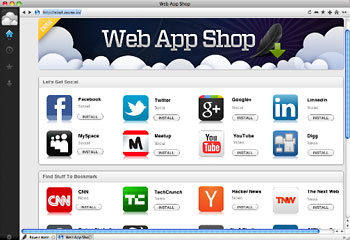 Browsing history is usually relegated to a simple list of links
or a menu in most browsers. Raven's history browser provides an
organized list of pages you've visited with a preview pane, allowing
you to preview the page before you visit it again. The search box above
your history list lets you find that page you have trouble remembering.
History will forever be altered thanks to Raven.
Browsing history is usually relegated to a simple list of links
or a menu in most browsers. Raven's history browser provides an
organized list of pages you've visited with a preview pane, allowing
you to preview the page before you visit it again. The search box above
your history list lets you find that page you have trouble remembering.
History will forever be altered thanks to Raven.
Raven's developers believe people have two types of bookmarks - ones you use everyday which they call favorites, and pages you find that you want to read later but don't necessarily want to keep cluttering you bookmarks menu in perpetuity. With Raven you can simply tap the "add" icon in the menu bar, decide if it is to be a favorite or a bookmark. Raven can also automatically send your bookmarks to Instapaper or you can read them in text only mode. Favorites will be added to the menu for quick access.
Raven's new suggestion feature scours both your favorites and your history to provide a number of links to sites you commonly visit or have visited before. No need for a bookmarks bar, simply type the first view characters and "boom!": - a list of pages that match what you're looking for will appear. Raven also combines the address bar with the search box. Simply enter a keyword instead of an address and Raven will search Google for you and provide you more results to find what you are looking for.
Raven debuts with a handful of menu items which include the ability to add a new favorite, access your favorites list or create new tabs. Single column mode will make Raven pretend it's a mobile web browser. This allows you to reduce the width of the window to experience the site just as you would on a smartphone.
System requirements:
- You must have at least Mac OS X 10.6 Snow Leopard in order to install Raven.
- At least 1 GB of memory recommended,
- A 1 GHz Intel processor or better
- 1024 x 768 display resolution
Link: Raven
Adobe Offers 20% Off When Upgrading from CS2, CS3, and CS4 to CS 5.5
PR: Adobe Systems Incorporated is offering a promotion giving Creative Suite users on older versions of the design software a special opportunity to upgrade from their individual or suite product to the latest version including Creative Suite 5.5, Photoshop CS5, or Illustrator CS5 at a 20% discount.
The offer runs through December 31, 2011 giving creative professionals a chance to upgrade to the latest in design software capabilities and performance.
This limited offer will be honored by all Adobe Resellers and adobe.com for customers with a valid license to one of the qualifying CS2, CS3, or CS4 products below:
- Design Premium; Design Standard; Web Premium; Web Standard; Production Premium; or Master Collection
- Production Studio Premium or Standard; Design Bundle, Web Bundle; Video Bundle; or Macromedia Studio 8
- Adobe After Effects; Adobe Flash Professional; Adobe Illustrator; Adobe Audition; Adobe Dreamweaver; Adobe Fireworks; Adobe InDesign; Adobe Photoshop; Adobe Photoshop Extended; Adobe Premiere Pro
The Adobe Creative Suite 5.5 product line enables designers and developers to target popular and emerging smartphone and tablet platforms, as the revolution in mobile communications fundamentally changes the way content is distributed and consumed. Substantive advances to HTML5, Flash authoring, digital publishing and video tools as well as new capabilities that kick-start the integration of tablets into creative workflows, anchor the new Adobe Creative Suite 5.5 product family.
Additional information about the promotion can be found in the Terms and Conditions online.
Link: 20% Off Upgrade Offer on CS 5.5 (offer ends Dec. 31, 2011)
Desktop Mac Deals
Low End Mac updates the following price trackers monthly:
- Mac mini deals
- Intel iMac deals
- Mac Pro deals
- Power Mac G5 deals
- iMac G5 deals
- Power Mac G4 deals
- iMac G4 deals
- eMac deals
- Power Mac G3 deals
- iMac G3 deals
For deals on current and discontinued 'Books, see our 13" MacBook and MacBook Pro, MacBook Air, 13" MacBook Pro, 15" MacBook Pro, 17" MacBook Pro, 12" PowerBook G4, 15" PowerBook G4, 17" PowerBook G4, titanium PowerBook G4, iBook G4, PowerBook G3, and iBook G3 deals.
We also track iPad, iPhone, iPod touch, iPod classic, iPod nano, and iPod shuffle deals.
Join us on Facebook, follow us on Twitter or Google+, or subscribe to our RSS news feed
Links for the Day
- Mac of the Day: PowerBook 190cs, introduced 1995.08.28. The last 680x0-based PowerBook could take a PowerPC upgrade.
- Support Low End Mac
Recent Content
About LEM Support Usage Privacy Contact
Follow Low End Mac on Twitter
Join Low End Mac on Facebook
Favorite Sites
MacSurfer
Cult of Mac
Shrine of Apple
MacInTouch
MyAppleMenu
InfoMac
The Mac Observer
Accelerate Your Mac
RetroMacCast
The Vintage Mac Museum
Deal Brothers
DealMac
Mac2Sell
Mac Driver Museum
JAG's House
System 6 Heaven
System 7 Today
the pickle's Low-End Mac FAQ
Affiliates
Amazon.com
The iTunes Store
PC Connection Express
Macgo Blu-ray Player
Parallels Desktop for Mac
eBay

